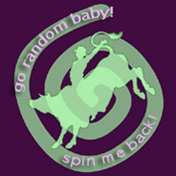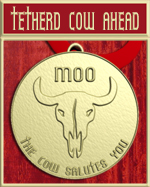Sun 20 May 2007
Convolution
Posted by anaglyph under Art, Mathematics
[12] Comments
I have been working with some really interesting generative functions in my artwork and I thought you might like to see some of the results.
(Click on the image and type ‘N’ for Next or ‘P’ for Previous)
The kinds of mathematical systems I’m using for these systems are deeply fascinating. All the images you can see in the above slideshow are closely related, even though they might look substantially different. They seem to resemble complicated organic lifeforms and yet the maths that describes them is remarkably simple.
It works something like this: I outline a basic element, let’s say a small lozenge shape and a circle. Then I tell the maths to do a very simple thing – make a two copies of those shapes in the next generation, displace them in space and rotate them a little. Each subsequent generation executes the same instructions.
This simple set of rules gives rise to a branching structure like you might see in a tree. If I add a few more basic commands (a little random variation in the shapes, some colour change over generations) an astonishing piece of magic happens – the resulting images look organic – even like creatures you might find in the real world. All kinds of phenomena that I don’t specifically code (such as asymmetry and textural effects) appear spontaneously.
I’ve only begun to experiment with these concepts and I fully expect to see some truly wonderful results from this work.





as always your images amaze me
when I’m a millionairess I’m going to purchase your entire back catalogue
Jeez!
He makes a name for himself as a Reverend and next minute he’s designing new critters!
It’s a beautiful world :)
Very lovely. It’s things like this that make me regret I didn’t study more mathematics. Ah… woulda coulda shoulda.
Are you sure one of those isn’t the National Flower of Australia?
It can’t be modern art, it doesn’t look like crap
I love Tussock. Thankyou for sharing.
nursemyra: If you speed up the earnings a bit I’ll give you a discount….
evenstar: Critters R Us! There’s even cooler stuff in the pipeline. Who’da thought there’d be so much spook in mathematics!
Phoebe Fay: I doubt one of these would ever make it to National Flower status – most of the government here thinks that maths is what you use to make your next big takeover bid.
din: I think I can take that as a compliment!
Pil: Thanks Patron!
So..uh…fractals?
This kind of math does have things in common with fractals – for instance it invokes recursion – but it is not fractal math.
Fractal math requires conditions not met by these equations – self-similarity and certain dimension-satisfying circumstances.
Recursion, one of the things that give fractal images that ‘curly’ look is almost certainly something that is exploited in natural objects. If you think about it, it makes a lot of sense because the instruction for recursion is so bogglingly simple – take something you already did and make another one like that. Extra conditions on this are simple too – take something you already did and make another one like that but make it a tiny bit bigger and rotate it a few degrees each time you do it.
So you get a pattern for a seashell, or a ram’s-horn.
Recursive instructions can be awesome, and they take up so little data to generate extraordinary variation.
Beautiful and thought provoking. You are tearing down the walls between science and art and religion, for which some may not thank you, but *ptui* to them!
I can see the recursion being handy. I was actually just giving you a little shit. I remember some cranky vitriol last time someone said the word “fractal” on your site. Fractals are kind of boring unless your brain chemistry has been played with.
I try to remember that these branches of mathematics are, for most people, not the kinds of things we have any handle on from high school. I don’t even think kids these days are being taught this kind of stuff.
So when people leap to use the ‘f’ word they are mostly talking out of their arse – they have seen some rendered Mandelbrot sets and have heard the word ‘fractal’ and without really knowing what any of that means jump to the conclusion that this must be what they are seeing.
Just switching to Grumpy Old Man mode for a second – this is one of the downsides of the popularization of science. Now I’m all for making science widely accessible, but sometimes it gives people the illusion that they know a lot more about something than they do. When it comes to fractal math, the general MO for the average pop science show is to serve up some swirling ‘brot sets, breathlessly proclaim ‘fractals are everywhere in nature!!!’ and offer pictures of seahorse tails as evidence.
Unfortunately this is mixing up a lot of complicated concepts in one diffuse melting pot.
More importantly in respect to my own work, it means a very important point gets glossed right over, and at the risk of being even more boring, I’ll repeat it: the images I’m making are the result of simple instructions.
This is profound. It says that a few very simple mathematical rules can create unpredictable yet organized life-like beauty.
If we’ve discovered this trick in maths for making images on a computer, you can bet your bottom dollar that Nature has already been there for real.
One aspect of your latest crop I like is that they look less animalian. Probably has to do with the different set of instructions, but I think it illustrates very well what you were getting at: that what you are doing is simple intruction resulting in complexity.
Now imagine if you put your models into an imaginary place with a lot of latent energy, like a geothermal vent in the ocean or something, and then let them fight it out and compete for survival, you know, let their complexities compete and reproduce. That would be cool. Has that been done before?